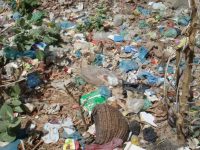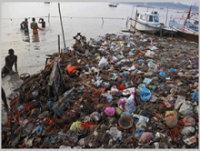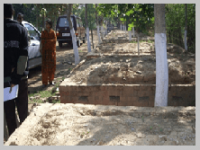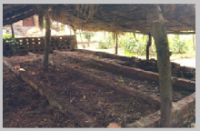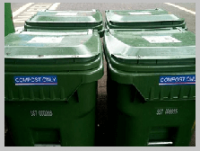Bio-degradable Waste Processing For Clean Environment
By
Pramila Gupta, Ex. Professor, AAI, Allahabad
Yash Krishi, Taknique Evam Vigyan Kendra, Allahabad
What is waste?
Waste is unwanted or undesirable material leftover or thrown after the completion of an Agriculture process. In other words, it can also be stated that any substance or matter which the holder discards or intends to discard is waste or which is generally not used again. A typical waste dump on the streets and /on the riverside is shown below.
This waste has to be sorted out for bio-degradable and Non-Bio-degradable waste. Biodegradable waste can be used for converting to manure for Agriculture.
Figure 1 – A typical Waste thrown on Roadside or the banks of the river
A. Use of Bio-degradable waste in making soil Improvers or Manure:
In Municipal Solid Waste (MSW) and near river Ganga or around, there are many elements like vegetable peelings, waste eatables, offered flowers, etc which are biodegradable. Other similar wastes are food waste, agriculture waste, animal dug, etc. In the city or on the banks of the Holy River many temples are also located. In these temples, tons of flowers are offered daily. These are also biodegradable and have to be disposed of.
Thus, a large volume of organic material is available from MSW or animal shelters, etc. This resource can be utilized by properly composting it into a value-added end product called Soil Improvers which is of superior quality manure to feed our hungry agriculture farms. These have many nutrient / organic matters for hungry soils. The bio-degradable waste can be converted to compost by NADEP technology or Vermi Method. In short, these methods are given here:
i). NADEP technology:
Adopting “NADEP technology” converts the bio-degradable waste to organic manure. In this method, a rectangular box-type brick structure of about 3m length x 1.6m width x 1m height is constructed on leveled ground. The brickwork is done using plain cement sand or lime mortar. The top layers are done with a little richer mix so as to give strength to structure. It may be provided with perforations in the walls all around by leaving half brick holes while doing the brickwork. The floor can be lined with plain bricks or simple earth
Waste material required for filling such size of Box includes:
- About 1400-1500 kg biodegradable/agricultural waste or flowers; 100-150 kg animal dung; 800 kg field soil.
- It is mixed well with cow dung & animal urine; water 1000-1500 liter. When all material needed is ready, the filling of the tank is completed within 48 hrs by pouring the material into layers.
- First is 15 to 20 cm with flower or organic waste keeping it wet with water or animal urine mixture, 2nd layer with 10 kg cow dung with about 150-liter water, 3rd layer with 50-60 kg mud mixed with water like a paste?
Like this 4-5 layers are poured and finally, the filled tank is covered and sealed with a uniform paste of moist mud. The box top is kept moist by spraying water from time to time for about 2 – 3 months in the summertime.
Approximately 5-6 tons of good manure is ready per tank in about 3 months, containing nitrogen-0.5 %’ phosphorus-0.5-0.6 %, potash- 1.2-1.4% plus all the other nutrients required for agricultural crops which is good. Besides this, NADEP compost being rich in humus also improves the physical structure of farm soils.
ii). Vermicomposting:
Vermicomposting uses earthworms to turn biodegradable or organic wastes into very high-quality compost. This is one of the best ways of composting many types of wastes including flowers, kitchen and animal waste, etc.
- For this technology, the most convenient pit or chamber is of size is 3m x 1m x 0.75m as shown in figure 3.
- The size and number of chambers can be changed or determined according to the volume of flower or agricultural waste mixed with animal dug. Earthworms are introduced into the loamy material/soil, which they will inhabit as their home and grow.
- In vermi beds of about 50 to 60 cm thick, about 200 or 1 Kg earthworms are introduced in the pit. The bedding for the vermin composting system must be able to retain both moisture and air while providing a place for the worms to live.
- About 1 ½ to 2 tons of good manure can be ready from such pit in about 1 – 2 months.
iii). Kitchen Waste Manuring:
Small plastic storage containers inconvenient or a variety of sizes as shown in figure 3 can also be used for Vermicomposting. These containers can easily be transported to suitable locations. These can be made or cast out of waste plastic begs converted to granular as discussed earlier.
Similar to NADAP technology this Vermi-Composting contains more nitrogen, many times more phosphorus, and potassium. They are rich in humus acids and improve the structure of the soil. These containers and methods can also be used by household Kitchen waste to convert into manure for the kitchen garden.
B. Generating Energy from Waste:
For this process, generally Biodegradable waste or Waste Plastics is used. The most common method of converting waste to energy generation is ‘Incineration‘. In simple terms, it stands for a type of waste treatment process, where the Biodegradable form of waste is collected and burnt at high temperatures. Waste treatments that are conducted involving high temperatures are called Thermal treatment. The heat generated from this thermal temperature is then used to create energy. Several countries in the world, especially in Europe are experimenting with Incineration as an alternate means of energy production.
| Thermal technologies | Non-thermal technologies |
| De-polymerization uses thermal decomposition where in the presence of water, the organic or bio degradable compounds are heated at high temperatures. This process of thermal decomposition is called Hydrous Pyrolysis in scientific terms.
The process without the use of oxygen is called Pyrolysis. Derived from Greek it is literally the synthesis of the terms, Fire and Separating. The process usually takes plastic and bio-mass as their primary ingredients. The rest works as a thermo chemical decomposition. This is again conducted at high temperatures and involves parallel changes of the chemical composition and physics. Gasification is another developing process employed from waste to energy generation. Gasification converts carbonaceous substances into carbon dioxide, carbon mono oxide and some amount of hydrogen. This process like incineration employs high temperatures to obtain results, however the major difference is that combustion does not occur over it. Steam and/or oxygen is also used in this procedure where usually fossil fuels or organic substances are used. The gas that is produced from the whole procedure is called Synthesis gas and is considered as a good means of alternate energy. |
Fermentation is also being developed as a form of waste to energy management. Anaerobic digestion is a slow process. Here in micro organisms are used to destroy the biodegradable content.
No oxygen is present during this procedure. It is used both domestically and even on a commercial level to tap the release of energy during the process and use it. Anaerobic technologies are seen as good agents to reduce the green house gases from the atmosphere and also as a worthy replacement of fossil fuels. The process works as a boon for developing countries for creating low energies for cooking and lighting in homes. Both China and India are extensively using this technology. |

